Petsafe Wireless Containment PIF-300 Manual
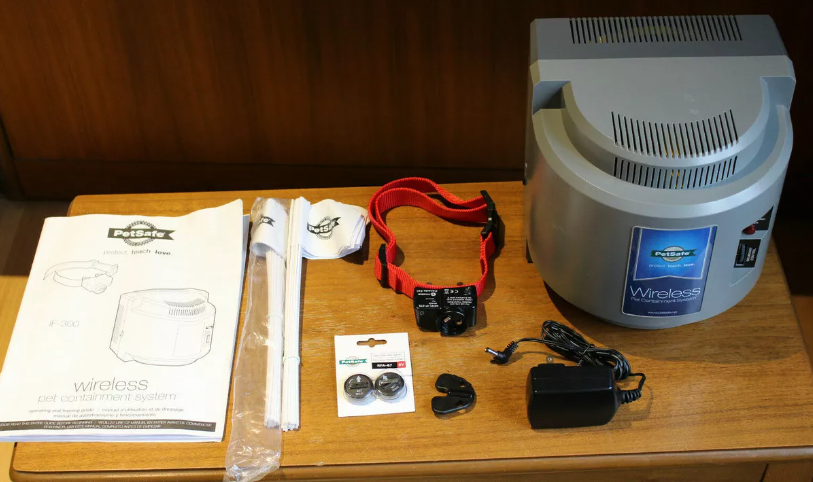
Content
Introduction of PetSafe Wireless Containment System PIF-300
The PetSafe Wireless Containment System PIF-300 is a revolutionary pet containment solution that provides your furry friends with the freedom to roam in your yard without the risk of them running away. This wireless system is easy to install, adjust, and move, making it a convenient choice for pet owners. The estimated price of the PetSafe Wireless Containment System PIF-300 is around $250 to $300, and it was launched in 2015.
Components
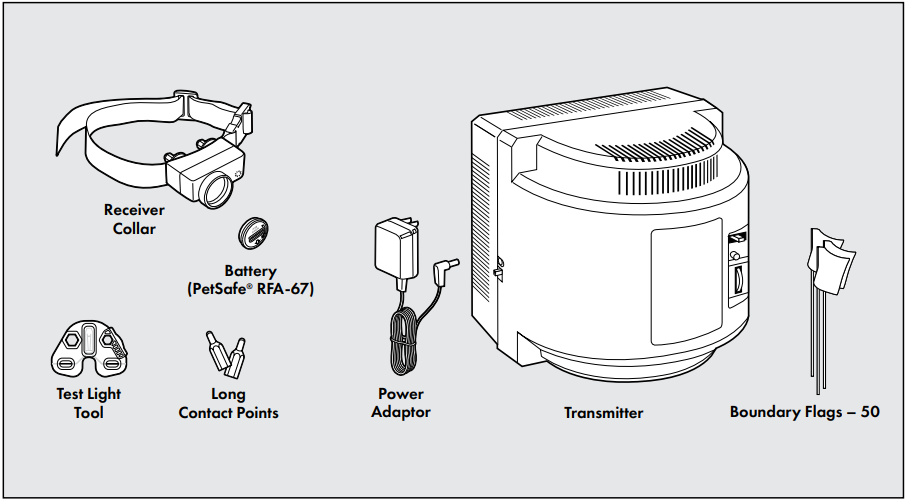
Other Items You May Need
- Pliers
- Scissors
- Lighter
- Drill & mounting hardware
- Tape measure
- Non-metallic collar and leash
PIF-300 Specifications
- Wireless design with a coverage area of up to half an acre (180 feet in diameter).
- Waterproof receiver collar fits neck sizes from 6 to 28 inches.
- Five adjustable levels of correction, plus a tone-only mode.
- Collar uses a rechargeable battery that lasts up to 2 hours.
- System includes a charging cradle and power adapter.
- Low battery indicator on the collar and a low battery warning on the transmitter.
- Built-in light sensor for nighttime safety.
- Portable and easy to install, with no wires to bury.
How the System Works
The PetSafe Wireless Pet Containment System has been proven safe, comfortable, and effective for pets over 8 lb. The system works by transmitting a radio signal up to 90 ft. in all directions. You temporarily define the pet area with boundary flags for a visual aid in training your pet. Your pet wears a receiver collar with contact points that touch his neck, and, once trained, is allowed to roam freely in the pet area. When your pet reaches the boundary zone, the receiver collar gives a warning tone before delivering a safe static correction through the contact points to get his attention until he returns to the pet area.
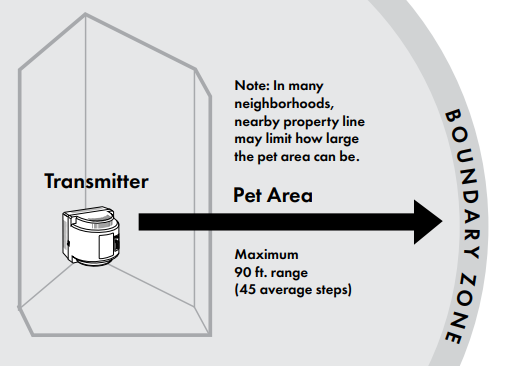
PetSafe Wireless Containment System Key Definitions
- Pet Area: Distance from the transmitter where your pet can roam freely.
- Boundary Zone: 2 to 3 ft. wide area outside the pet area where your pet’s receiver collar will begin to beep and then begin to deliver a static correction. The correction will start in the boundary zone
and continue anywhere beyond the pet area.
Note: The receiver collar is equipped with a safety timeout feature that will stop correcting after 30 seconds if your pet remains outside the pet area. - Receiver Collar: Receives the radio signal from the transmitter.
- Correction Level Button: Adjusts the level of static correction your pet receives outside the pet area.
- Receiver Indicator Light: Indicates the level of correction at which the receiver collar is set. This light also serves as a low battery indicator.
- Contact Points: Deliver the safe static correction when your pet moves into the boundary zone.
- Transmitter: Transmits the radio signal and is the center of the pet area.
- Power Jack: Where the power adaptor plugs into the transmitter. The transmitter is powered by a standard 120 volt outlet.
- Boundary Switch: Adjust according to the size of the pet area desired. Note: Adjusting the switch does not change the level of static correction on the receiver collar.
- Power Light: Indicates when the transmitter is on.
Receiver Collar
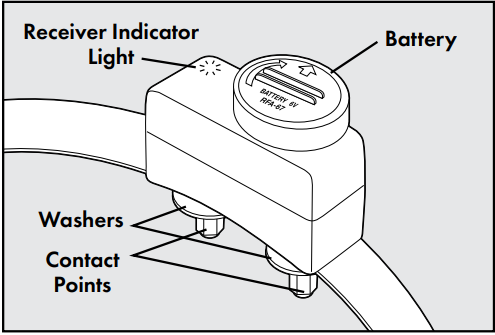
Transmitter
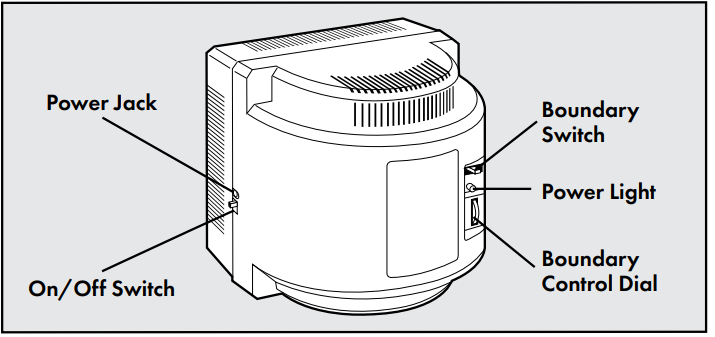
PetSafe Description
The PetSafe Wireless Containment System PIF-300 is a convenient and effective way to keep your pets safe and secure in your yard. The wireless system sets up in just a few hours and can cover up to half an acre of space. The system includes a waterproof receiver collar that fits neck sizes from 6 to 28 inches and can be adjusted to five different levels of correction. The collar also features a tone-only mode for training. The rechargeable battery lasts for up to two hours, and the charging cradle and power adapter are included. The system also includes a low battery indicator on the collar and a warning on the transmitter. The built-in light sensor ensures your pet's safety at night.
Operating Guide
Set up the Transmitter
Important: You may need to move the transmitter several times before determining the final location. The transmitter is located at the exact center of the pet area.
Place the transmitter
- At least 2 ft. above the floor located on the ground floor of your home.
- In a dry, well ventilated, protected area.
- In an area where temperatures do not fall below -10°F (-23°C) or rise above 104°F (40°C).
- Mounted to a wall, on a non-metal table, or other hard surface to ensure proper ventilation (1A). A mounting template is included on the back of this guide.
- At least 3 ft. from large metal objects, as these items may reduce the size and shape of your pet area (1B). Placing the transmitter inside a metal building or shed can reduce the maximum range of the system.
Notice
- Do not place anything on top of the transmitter or cover any ventilation holes. This may overheat the transmitter and cause early transmit failure.
- Do not place the transmitter in a closet or any other confined, unventilated area.
- Do not place the transmitter on or near a metal surface.
To maximize your pet area, make sure the boundary switch is on “high” and the boundary control dial is set to “8” (1C). Plug the power adaptor into the power jack and a standard 120 volt outlet. Turn the transmitter on (1D).

Prepare the Receiver Collar
- Your receiver collar comes with short contact points installed. Use the long contact points for pets with long or thick hair. Tighten the contact points using the test light tool (2A) one-half turn beyond finger tight. Check the tightness weekly.
- Insert and Remove the Receiver Collar Battery
Note: Do not install the battery while the receiver collar is on your pet. - This receiver collar utilizes a replaceable PetSafe battery (RFA-67). This unique battery is designed to make battery replacement easier and increase water protection.
- To insert the battery, align the symbols on the battery (arrow) and receiver collar (triangle) (2B). Use the edge of the test light tool (2B) to turn the battery clockwise until the arrow lines up with the lock symbol on the housing.
To remove the battery, turn the battery counter-clockwise using the edge of the test light tool (2C). DO NOT attempt to cut into or pry open the battery. Be sure to discard the used battery properly.
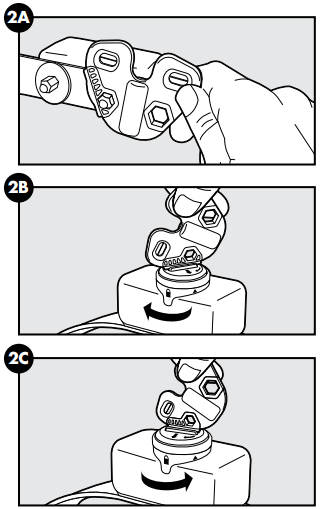
WARNING: Risk of explosion
If batteries are replaced by an incorrect type. Do not short circuit, mix old and new batteries, dispose of in fire, or expose to water. When batteries are stored or disposed, they must be protected from shorting. Dispose of used batteries properly.
Note: Before replacing the battery, discharge all the power by holding the mode button for at least 30 seconds until the LED is no longer illuminated. A replacement PetSafe battery (RFA-67) can be found at many retailers. Contact the Customer Care Center or visit our website at https://www.petsafe.com/ to locate a retailer near you.
Set the Static Correction Level
Read all steps before attempting to set the static correction level.
- Remove the clear plastic cover with the edge of the test light tool to expose the correction level button (2D).
- With the battery installed, press the correction level button and release when the receiver LED indicator light lights up (2E).
- The receiver LED indicator light will emit a series of flashes representing the static correction level.
- Increase the static correction level by pressing and releasing the correction level button within 5 seconds of the previous series of flashes.
After setting the static correction level, replace the cover to protect the correction level button.
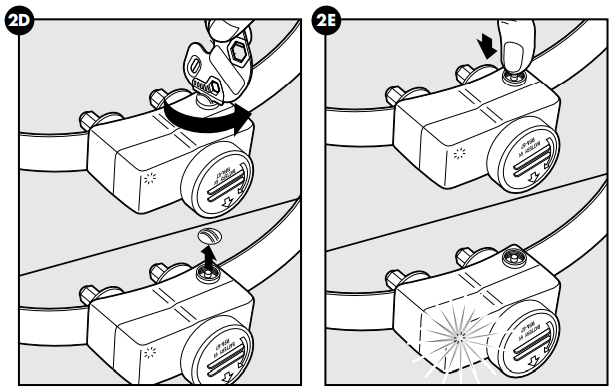
The static correction levels increase in strength from 1 to 6. Pushing the correction level button while the receiver collar is on level 6 will cause the receiver collar to revert to level 1. Refer to the Function and Response Table to choose the static correction level that best fits your pet. The receiver indicator light acts as a low battery indicator. The light will flash every 4 to 5 seconds when battery replacement is required.
Battery Contact Verification
- Remove the receiver collar from your pet.
- Press the button and verify that the LED light illuminates. If the LED light does not come on, remove the battery.
- Locate the metal tabs in the battery well.
- Gently lift the tabs to ensure that the battery will make good contact.
- Replace the battery into the receiver collar.
- Press the button and check that the LED light illuminates.
Function and Response Table | ||
Indicator Light Response | Static Correction Level | Receiver Collar Function |
1 flash | 1 | No static correction, tone-only |
2 flashes | 2 | Lowstatic correction |
3 flashes | 3 | Medium-low static correction |
4 flashes | 4 | Medium static correction |
5 flashes | 5 | Medium-high static correction |
6 flashes | 6 | High static correction |
Flashes once every 4 to 5 seconds | – | Indicates low battery |
Over Correction Protection
If your pet enters the boundary zone or continues anywhere beyond the pet area, this feature limits the static correction duration to 30 seconds. In the unlikely event that your pet leaves the pet area, he will not receive a static correction upon return to the pet area.
Adjust the Pet Area to Desired Size
- Make sure the entire pet area lies within your property boundaries (3A). Always start determining the boundary zone at the shortest distance from the transmitter. Place the boundary switch on “low” if the boundary zone will be less than 45 ft. from the transmitter.
- Make sure the receiver collar battery is properly installed, set the static correction to level 2 or above, and hold the test light contacts to the contact points (3B).
Note: If your next-door neighbor has an In-Ground Containment System, see the troubleshooting section on page 14.
Test Light Instructions
- Set the static correction to level 2 or above.
- Hold the test light contacts to the contact points (3B).
- Walk toward the boundary zone holding the receiver collar about waist high until the test light flashes (3C). Save test light for future testing.
Note: If the test light does not flash, install a new battery and retest. If test light still does not flash, contact the Customer Care Center.
To maximize your pet area, make sure the boundary switch is on “high” and the boundary control dial is set to “8.” Plug the power adaptor into the power jack and a standard 120 volt outlet.
- Two-Person Method
Hold the receiver collar about waist high with the logo side facing away from the transmitter and the contact points facing upwards.
Walk to the edge of the desired pet area. Facing away from the transmitter, hold the receiver collar at the edge of the desired pet area (3C).
Starting with the boundary control dial set to “8,” have a second person turn the dial down SLOWLY. When the receiver collar starts to beep, tell the person to stop turning the boundary control dial. Record your settings below for future reference. One-Person Method
Measure the shortest distance from the desired boundary zone to the transmitter. Find the distance on the transmitter range chart on page 10 and set the boundary switch and boundary control dial. Hold the test light contacts to the contact points (3B).
Take the receiver collar to the boundary zone with the logo side facing away from the transmitter and contact points facing upwards (3C). Hold the receiver collar about waist high until it beeps and the test light flashes.
If the receiver collar beeps before or after the desired boundary zone, return to the transmitter and adjust the boundary control dial. Repeat this process until the receiver collar is beeping at the desired location. Record your settings on page 10 for future reference.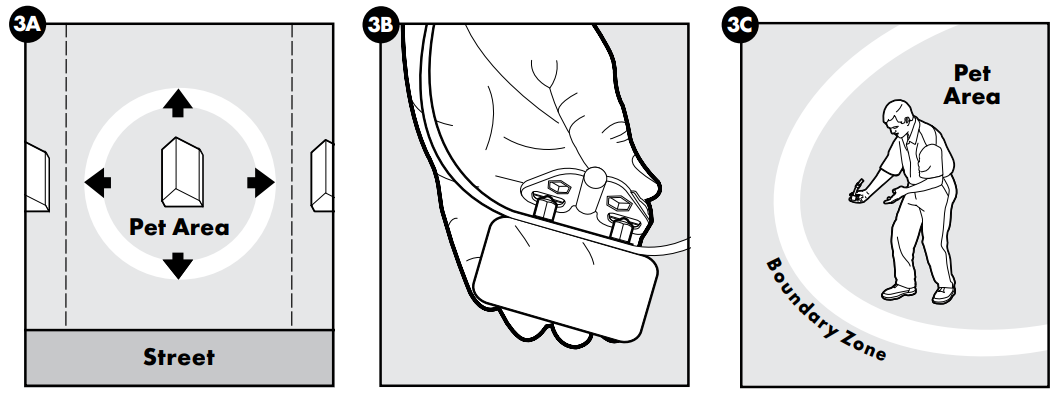
Transmitter Range Chart
Boundary Control Dial Position | Boundary Switch Low (-) | Boundary Switch High (+) |
1 | 5–10ft. | 5–10 ft. |
2 | 5–10 ft. | 5–10 ft. |
3 | 15–20ft. | 25–35 ft. |
4 | 20–25 ft. | 42–55 ft. |
5 | 25–30ft. | 55–65 ft. |
6 | 35–40 ft. | 75–85 ft. |
7 | 40–45ft. | 85–90 ft. |
8 | 40–45 ft. | 85–90 ft. |
Note: These distances are approximate.
Record Your Settings
Location | Final Boundary Switch Setting (High + or Low -) | Final Boundary Control Dial Position (1–8) | Receiver Static Correction Level (1–6) |
Home |
|
|
|
Camping |
|
|
|
Vacation |
|
|
|
Other |
|
|
|
|
|
|
|
|
|
|
|
Place the Boundary Flags
The boundary flags are visual reminders for your pet of where the boundary zone is located. The receiver collar will activate within 2 to 3 ft. of the boundary flags.
- Using the test light, with the static correction level set at 2 or greater, hold the receiver collar at your pet’s neck height with logo side facing away from the transmitter.
- Walk towards the boundary zone until the receiver collar tone sounds and the test light flashes. (4A).
- Place a boundary flag in the ground (4B).
- Walk back into the pet area until the repeating tone stops.
Repeat this process around the boundary zone until it is marked with boundary flags every 10 ft.
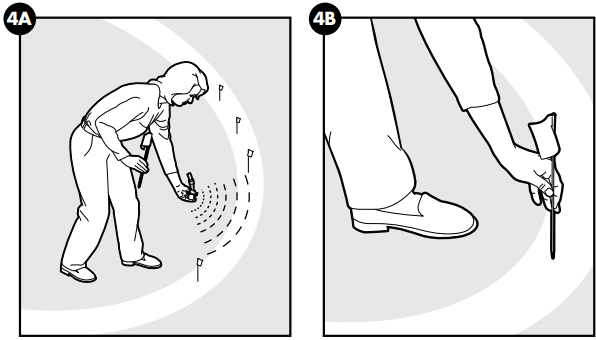
The boundary flags may be in different parts of the boundary zone and may not be in a line. The boundary zone is 2 to 3 ft. wide.
Fit the Receiver Collar
Important: The proper fit and placement of your receiver collar is important for effective training. The contact points must have direct contact with your pet’s skin on the underside of his neck.
Caution: Please read and follow the instructions in this manual. Proper fit of the receiver collar is important. A receiver collar worn for too long or made too tight on the pet’s neck may cause skin damage, ranging from redness to pressure ulcers. This condition is commonly known as bed sores.
- Avoid leaving the receiver collar on your pet for more than 12 hours per day.
- When possible reposition the receiver collar on the pet’s neck every 1 to 2 hours.
- Check the fit to prevent excessive pressure; follow the instructions in this product manual.
- Never connect a leash to a receiver collar with contact points. It will cause excessive pressure on the contact points.
- When using a separate collar for a leash, do not put pressure on the receiver collar.
- Wash your pet’s neck area and the contact points of the receiver collar weekly with a damp cloth.
- Examine the contact area daily for signs of a rash or a sore.
- If a rash or sore is found, discontinue use of the receiver collar until the skin has healed.
If the condition persists beyond 48 hours, see your veterinarian.

For additional information on bed sores and pressure necrosis, please visit our website. These steps will help keep your pet secure and comfortable. Millions of pets are comfortable while they wear stainless steel contact points. Some pets are sensitive to contact pressure. You may find after some time that your pet is very tolerant of the receiver collar. If so, you may relax some of these precautions. It is important to continue daily checks of the contact area. If redness or sores are found, discontinue use until the skin has fully healed. You may need to trim the hair in the area of the contact points. Never shave the dog’s neck; this may lead to a rash or infection.
To assure a proper fit, please follow these steps:
- Make sure that the battery is not installed in the receiver collar.
- Start with your pet standing comfortably (5A).
- To make it easier to hear the warning tone, place the receiver collar on your pet with the logo side of receiver collar facing up.
- Center the contact points underneath your pet’s neck, touching the skin.
CAUTION: You may need to trim the hair in the area of the contact points. Never shave the dog’s neck; this may lead to a rash or infection. - Check the tightness of the receiver collar by inserting one finger between the end of a contact point and your pet’s neck. The fit should be snug but not constricting (5B).
- Allow your pet to wear the receiver collar for several minutes then recheck the fit. Check the fit again as your pet becomes more comfortable with the receiver collar.
- Trim the receiver collar as follows (5C):
- Mark the desired length of the receiver collar with a pen. Allow for growth if your pet is young or grows a thick winter coat.
- Remove the receiver collar from your pet and cut off the excess.
- Before placing the receiver collar back onto your pet, seal the edge of the cut collar strap by applying a flame along the frayed edge.
- Put the battery in the receiver collar.
Re-thread the Receiver Collar
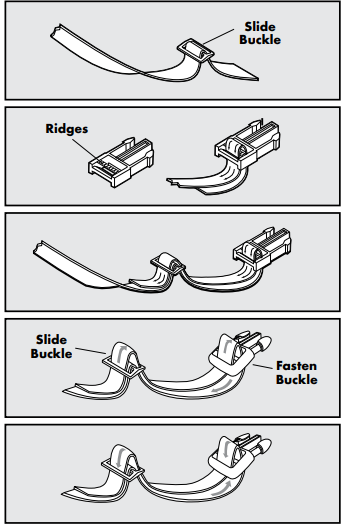
- The slide buckle prevents the receiver collar from becoming loose around your pet’s neck.
- The ridges must be facing up; the receiver collar will slip if it is not properly threaded.
- To loosen: Slide the strap through the Slide and Fasten Buckles and pull down.
- To tighten: Slide the strap up through the Fasten Buckle and pull through the Slide Buckle.
Setup Guide of PetSafe Wireless Containment System PIF-300
Setting up the PetSafe Wireless Containment System PIF-300 is easy and straightforward. Here are the steps to follow:
- Charge the receiver collar for at least 2 hours.
- Plug in the transmitter and adjust the dial to set the desired boundary width.
- Place the transmitter in a central location in your home.
- Turn on the receiver collar and adjust the correction level as needed.
- Test the system by walking your pet around the boundary area and observing the collar's response.
- Train your pet to stay within the boundary area using the tone-only mode and positive reinforcement.
Training
- Remember that this system is not a solid barrier. Using it successfully requires that you spend some time training your pet.
- Finish each training session on a positive note with lots of praise and play. Remove the receiver collar after each training session.
- While your pet is still learning the boundary, contain him by another means, such as with a pen or a leash.
- Put a separate non-metallic collar on your pet’s neck and attach a leash
- Be sure to place the receiver collar on your dog’s neck with the PetSafe® logo facing up.
- If your pet appears to be stressed, slow down the training schedule, add additional days of training or increase the amount of play time. Common stress signals include pulling on the leash toward the house, ears tucked or pulled back, tail down or tucked between legs, body lowered, nervous/frantic movement or stiffening of the pet’s body, lip-licking or yawning.
Day 1
For the first day, start with the receiver collar set to level 1, tone-only. With your pet on a leash and with his favorite treats on hand, allow him to explore the pet area (6A). Allow your pet to cross the boundary (6B) and hear the tone from the receiver collar, then ask him to come back into the pet area (6C) and praise and reward him. Your goal is for your dog to associate being inside the pet area with rewarding experiences. Dogs are sensitive. Keep your mood upbeat as dogs can understand when you are happy or upset. Do 2 or 3 training sessions for about 10-15 minutes each. Do not try to do too much too quickly. More frequent short sessions are better than less frequent, longer sessions.
Days 2–4
On days 2 through 4, repeat this process, but with the receiver collar set to level 2—the mildest static correction level. Closely observe your pet’s behavior while he is in the boundary zone (6B), and note whether or not your dog responds to the correction. Indicators of a response are looking around in curiosity, flicking of the ears or scratching at the receiver collar. If he does not respond, check the fit of the receiver collar to make sure the contact points are making contact with his skin. If the receiver collar is fit correctly and your dog does not respond, then move up to the next correction level and repeat the process. Do 2 or 3 training sessions for about 10–15 minutes each. Your goal is for your dog to consistently choose to stay in the pet area. If necessary, add in more days of training before moving on to the next step.
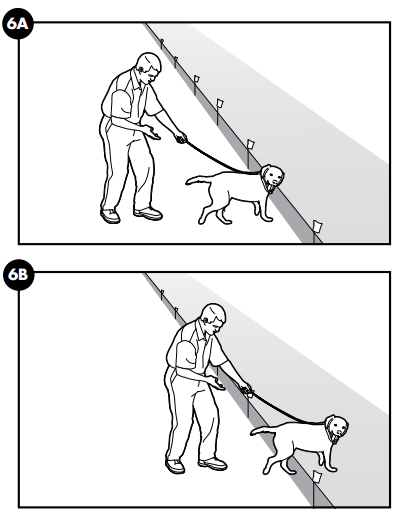
Days 5–8
On days 5 through 8, retain the receiver collar settings from the last training session, but stage some distractions to test your dog’s reliability. The goal is to have your pet stay within the boundary even with new temptations. Start with simple temptations and work your way up.
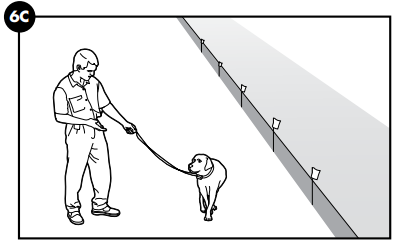
Some examples are
- Have a family member cross from inside the boundary and exit it.
- Place a toy outside the boundary.
- Have a friend or neighbor walk another pet outside the boundary area.
Remember to keep your pet on a leash throughout this process while he is still learning the boundary. Also, never coax your pet to leave the pet area.
Caution: Be sure the extra collar does not put pressure on the contact points.
Days 9–30
Once your pet consistently respects the boundary zone regardless of distractions or temptations, he is ready for the next step: unleashed supervision (6D). Stay close by with a leash at hand. Play with your pet for a while during the first few sessions. If your dog does not try to cross the boundary zone, occupy yourself with another task in the yard, and allow him to freely explore. Continue watching your pet. If he escapes, remove the receiver collar and lead him back into the pet area. Start these sessions at about 15 minutes and gradually work up to an hour or more. When your pet proves trustworthy, you can let him out on his own. Continue to check on him regularly. You can remove every other boundary flag every 4 days until all the flags are removed. Save them in case you move or need to train another pet.
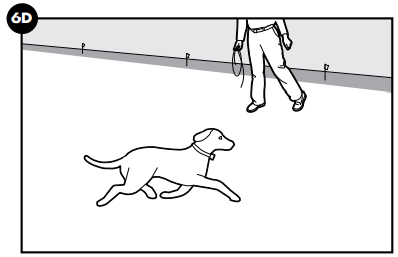
Taking Your Pet Out of the Pet Area
Important: Remove the receiver collar and leave it at home. Once your pet learns the boundary zone, he will be reluctant to cross it for walks or car rides.
- Replace the receiver collar with a regular collar. Put your pet in a car that is within the pet area and drive him out of the pet area (6E).
Replace the receiver collar with a regular collar and leash. Walk your pet out of the pet area while giving a command such as “OK” at a specific place along the boundary zone (the end of your driveway, sidewalk, etc.). Always leave the pet area from the same spot in your yard with a leash and your pet will associate leaving the pet area only on a leash, only at this spot, and only with a person. You may initially need to convince your pet to leave the pet area with a treat and lots of praise.
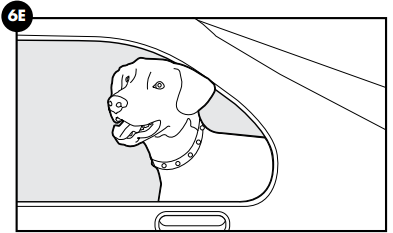
Note: You may also carry your pet out of the pet area.
Congratulations! You have now completed the training program. You are both ready to enjoy more freedom. Just make sure to continue to check the tightness of the receiver collar and remove it when it is not in use.
Wireless-to-Go
Your Pet Safe Wireless Pet Containment System is completely portable. Follow the setup procedures (Steps 1 through 4) wherever you wish to have containment of your pet. Reestablish the pet area and mark it with boundary flags so your pet knows his boundary zone. Place the transmitter indoors at least 3 ft. from large metal objects.
Note: If setting up in a metal building or vehicle, the maximum size of the pet area may be reduced. Be sure to remove the receiver collar battery before turning off the transmitter. If you want to power the transmitter from a car or other DC source, use an inverter rated for 50 watts or more.
PetSafe Wireless Containment System Troubleshooting
| Issue | Solution |
|---|---|
| The receiver collar is not beeping when setting up the boundary zone. | Use the test light as explained in the "Test Light Instructions" to determine the boundary zone location. Check that the transmitter is set up according to directions and install a new battery. |
| The receiver collar is not beeping or administering a static correction. | Check that the transmitter is plugged into a working 120-volt outlet, turned on, the power light is on, and the transmitter controls are set at your desired settings. Check the receiver battery to make sure it is installed properly. Replace the receiver collar battery. |
| The receiver collar is beeping everywhere. | Check that the transmitter is plugged into a working standard 120-volt outlet, turned on, the power light is on, and the transmitter controls are set at your desired settings. |
| The receiver collar is beeping inside the house. | Remove the receiver collar from your pet when indoors. Ensure the entire house is within the pet area. Adjust the pet area to include the entire house if necessary. |
| My pet is receiving a static correction in his metal crate. | Remove the receiver collar from your pet when placing him in his metal crate. |
| The boundary zone seems to fluctuate. | The boundary zone fluctuation is normal and may vary due to electromagnetic interference. Adjust the receiver collar activation distance if necessary. |
| The receiver collar activates in the middle of the yard. | Consider relocating the transmitter if large metal objects or electronic noise is causing signal loss. |
| The receiver collar is beeping but my pet is not responding to the static correction. | Ensure the static correction level is set at 2 or above. Test the receiver collar with the test light. Adjust the fit of the collar, trim your pet’s fur, or use longer contact points if needed. Increase the static correction level and repeat training steps. |
| My pet reacts strongly to the static correction and has become fearful. | Lower the static correction level. Use a leash during the first exposure to static correction and end training sessions positively. |
| The power light is not on. | Check the power adapter is plugged into a working outlet. Replace the fence transmitter and/or power adapter if needed. |
| I was setting up the pet area and after turning down the boundary control dial, the receiver collar would no longer beep or correct. | Slowly adjust the boundary control dial to prevent the receiver collar from going into power-fail mode. |
| My next-door neighbor has an In-Ground Containment System, and the receiver collar does not activate near their property. | Reduce the size of the pet area or move the transmitter away from the neighbor's In-Ground Fence System to minimize interference. |
| The receiver collar has injured my pet’s neck. | Follow the safety information and fitting instructions to prevent pressure ulcers. Ensure the receiver collar battery is sealed and not leaking. |
One Year Non-transferable Warranty
What is covered: Radio Systems Australia Pty Ltd. (hereinafter referred to as “Radio Systems”) warrants to the original retail purchaser, and not any other purchaser or subsequent owner, that its product, when subject to normal and proper residential use, will be free from defects in material or workmanship for a period of one (1) year from the purchase date.
PetSafe Wireless Containment System PIF-300 Pros & Cons
Pros
- Wireless and portable system
- Easy to install and adjust
- Waterproof and rechargeable collar
- Five adjustable levels of correction
- Low battery indicator and warning
Cons
- Can only cover up to half an acre
- Not suitable for large or aggressive dogs
- Can interfere with other wireless signals
- Collar battery may not last long for some users
- Expensive compared to other containment systems
Customer Reviews about PetSafe Wireless Containment System PIF-300
Customers have praised the PetSafe Wireless Containment System PIF-300 for its ease of use and effectiveness in keeping pets safe. The wireless design and portability have been particularly appreciated, as well as the waterproof and rechargeable collar. However, some users have criticized the limited coverage area and the interference with other wireless signals. Some users have also reported issues with the collar battery not lasting long. Overall, the PetSafe Wireless Containment System PIF-300 has received mostly positive reviews and is considered a reliable and convenient solution for pet containment.
Faqs
How do I set up the PetSafe Wireless Containment System PIF-300?
What kind of batteries does PetSafe Wireless Containment System PIF-300 receiver collar use?
What should I do if PetSafe Wireless Containment System PIF-300 receiver collar is not working?
Are there different correction levels on the receiver collar PetSafe Wireless Containment System PIF-300?
Why is PetSafe Wireless Containment System PIF-300 receiver collar beeping but not administering a static correction?
How do I know if the boundary is set properly PetSafe Wireless Containment System PIF-300?
How often do I need to change PetSafe Wireless Containment System PIF-300?
How can I clean the receiver PetSafe Wireless Containment System PIF-300 ?
Can I adjust the PetSafe Wireless Containment System PIF-300 if my yard is smaller than 1/2 acre?
What should I do during bad weather PetSafe Wireless Containment System PIF-300?
Leave a Comment
